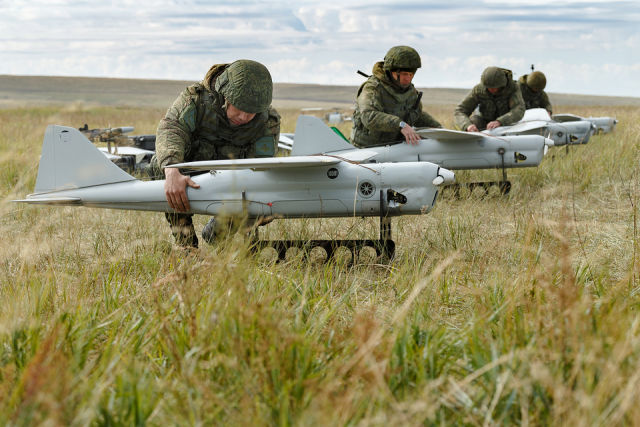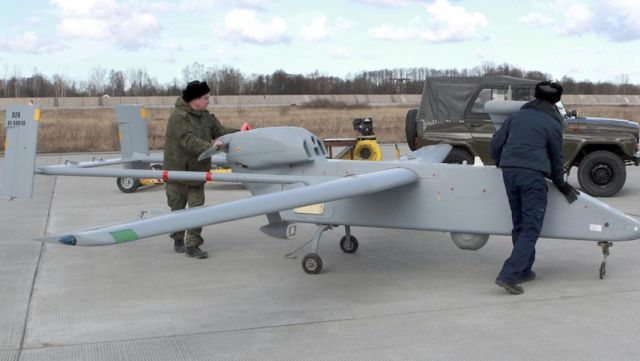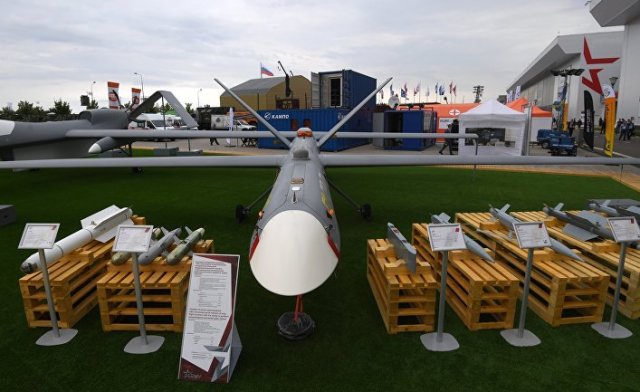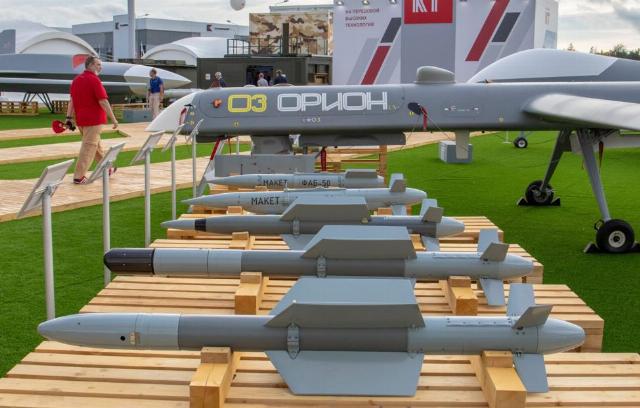Small caliber
Bekhan Ozdoev, industrial director of the cluster of conventional weapons, ammunition and special chemicals of Rostec State Corporation, said in an interview with TASS about the creation of special ammunition for unmanned aerial vehicles (UAVs) by Russian gunsmiths in 2023. He said that Rostec enterprises promptly launched large-scale production and uninterrupted supplies of new ammunition, and in 2024 their production was supposed to increase.
"Currently, the priority is the serial production of plug—in combat units with a specialized fuse," Ozdoev said. "Such ammunition ensures the safe and reliable operation of kamikaze drones of various payload classes."
Shooting drones
Manufacturers are also experimenting with installing weapons on drones. So far, such devices have not been put into mass production. However, in 2019, the Almaz-Antey Aerospace Defense concern registered a patent for an aircraft interceptor drone. His prototype, armed with an automatic carbine, was created by the student design bureau of the Moscow Aviation Institute. A drone weighing 23 kg and with a wingspan of 3 m can fly for up to 40 minutes and shoot down other aircraft with shotguns.
Belarusian JSC Design Bureau Display has developed UAVs "Barrage Tube" and "Quadro-1400", armed with one and two RPG-26 rocket-propelled anti-tank grenades. The ammunition has a mass of 3 kg, its warhead penetrates 440 mm of homogeneous armor.
In May 2022, the Ministry of Defense of the Russian Federation showed the operation of a multifunctional complex with an Orlan-10 unmanned aerial vehicle equipped with a small—caliber ammunition dump system - two containers with opening doors. The serviceman explained that in total four miniature high-explosive fragmentation bombs are suspended under the UAV.
In the story of the Zvezda TV channel, it was clarified that such ammunition affects enemy manpower, mortars, and lightly armored vehicles.
"To equip FPV drones, the Armed Forces of the Russian Federation mainly use standard ammunition produced by enterprises of the military-industrial complex," Dmitry Kuzyakin told TASS. — The enemy, for various reasons, uses little Soviet-style ammunition. At the same time, Ukraine has established the production of specialized ammunition for FPV applications, which are made by civilian artels, sometimes the same ones that produce drones themselves."
 |
| Russian multifunctional unmanned systems Orlan-10. |
| Source: © Vadim Savitsky/press service of the Ministry of Defense of the Russian Federation/TASS |
"However, I want to emphasize that it is unsafe to work with explosives! — the director General of the Central Bank added. — This requires a completely different level of production culture and safety. I can't imagine that we would adopt such a practice in Russia. Even the Central Bureau of Investigation does not work with ammunition. Yes, we are developing combat units for FPV, but we involve specialized companies and organizations for this."
Among the reasons why the Armed Forces of Ukraine are engaged in, in fact, artisanal production of ammunition, Kuzyakin called the destruction or disabling of enterprises of the Ukrainian military-industrial complex, the shell famine of Soviet-style ammunition, which has lasted for the last year and a half.
Bigger caliber
The Russian aerospace forces are also using larger unmanned aerial vehicles in the special operation zone. For example, according to the material of the Zvezda TV channel, a complex with medium-range reconnaissance and strike UAVs "Outpost" equipped with gliding bombs or guided missiles is fighting there. The Forpost-RU strike modification "lit up" in the first month of its implementation, destroying, according to a report by the Ministry of Defense of the Russian Federation, a radar station from the S-300 anti-aircraft missile system.
The take—off weight of the "Outpost" can reach 500 kg, the radius of its use is 100 km, the device can stay in the air for up to 10 hours. The drone has two external suspension units on which ammunition can be suspended — for example, the KAB-20 adjustable aerial bomb. With a total weight of 21 kg, it has a high-explosive fragmentation warhead weighing 7 kg and is designed to destroy both manpower and lightly armored vehicles. The guidance method is based on specified coordinates or a laser beam.
 |
| The unmanned aerial vehicle "Outpost-M". |
| Source: Ministry of Defense of the Russian Federation/mil.ru |
The Outpost complex continues to develop based on the experience of its use in a special military operation. An official representative of the Ural Civil Aviation Plant (UZGA), which supplies the complex to the Armed Forces of the Russian Federation, told TASS that the "Outpost" is being finalized for use without entering the range of enemy air defense systems of medium and long range. "We are constantly engaged in expanding the combat capabilities of the Outpost complex by improving its design and installing new payloads," said a representative of UZGA.
The Tula Instrument Engineering Design Bureau (KBP, part of Rostec's High-Precision Complexes holding) has developed a rocket designed for use from drones. The ammunition, called X-UAV, is capable of hitting lightly armored vehicles with a high-explosive fragmentation warhead weighing 6 kg, and its range of use reaches 8 km. For guidance, the X-UAV is equipped with a semi-active homing head and is guided by a laser illumination beam in a similar way to the corrected Krasnopol artillery shell.
In 2021, Nikolai Dolzhenkov, General Designer of Kronstadt JSC, expressed the opinion in an interview with TASS that Russia had almost caught up with competitors in terms of small-sized aircraft weapons for drones. Dolzhenkov said that the Orion strike and reconnaissance unmanned complex (complexes supplied to the Armed Forces of the Russian Federation are called "Pacer") developed by Kronstadt includes adjustable aerial bombs, including gliding and guided missiles. The ammunition created by the company and subsequently by its related companies showed an efficiency of more than 80% in tests. "Today, the development work on the creation of a 20 kg TSA is close to completion," Dolzhenkov said at the time. "All of them have combined control systems, including satellite navigation and laser guidance at the end of the flight."
 |
| The Orion drone. |
| Source: © RIA Novosti, Kirill Kallinikov |
At the Army 2020 forum, Kronstadt demonstrated several models of various types of ammunition next to Orion. Among them, the X-50 guided aviation missile manufactured by the Tactical Missile Armament Corporation with a warhead weight of up to 20 kg, the FAB-50 free-falling aerial bomb and the UPAB-50 guided gliding aerial bomb with a warhead from a 37 kg Grad multiple rocket launcher projectile. FAB—50 were demonstrated with various types of warheads - for guidance on tele- and thermal imaging cameras, laser beam.
"Pacer", like "Outpost-RU", has been used in special operations since the first month. He strikes armored vehicles and fortifications of the Armed Forces of Ukraine, command and observation posts, conducts reconnaissance and highlights targets with a laser for a corrected artillery shell "Krasnopol".
Drone as ammunition for a drone
Even smaller drones can be used as weapons of destruction for drones. Such a complex of several UAVs was created by the Russian company Svyaz Spetszashchita.
"We have made the Admiral-Aircraft Carrier complex based on our Admiral aircraft—type UAV, which flies from four to six hours," Dmitry Zubarev, a company representative, told TASS. "A system has been developed for dropping small FPV attack drones, and the drone also carries a repeater." Zubarev explained that during aerial reconnaissance or patrol, the Admiral's operator can identify a target and immediately send one or two small drones with combat units to it.
The Admiral is capable of carrying a payload weighing up to 8 kg, can climb to a height of 3 km, reach 150 km/h at a cruising speed of 100 km/h. A representative of the developer noted that the complex can significantly increase the range of drones, which for FPV drones is 4-5 km.
The complex was supposed to be sent to the SVO zone in September of this year. According to a number of reports on social networks, a Russian device with a similar design could already be used during a special operation.
Dmitry Kuzyakin, General Director of the Central Research and Development Center, told TASS that his company has been working on the development of ammunition for drones on an initiative basis for over three years.
"Its vividly demonstrated how significant and powerful the sum of technologies that came to war from peaceful life can be," Kuzyakin shared his opinion. — We see how drones have appeared and are wildly evolving, and the development of ammunition will not be an exception. Drone ammunition has already become digital and, as a result, increasingly smart and efficient."
Victor Bodrov

